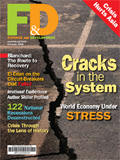 View this Issue Archive of F&D Issues Subscribe to Print Edition Write to us F&D welcomes comments and brief letters, a selection of which are posted under Letters to the Editor. Letters may be edited. Please send your letters to: fanddletters@imf.org. F&D Magazine Free Email Notification Receive emails when we post new
items of interest to you. |
IMF News IMF’s new liquidity facility The IMF has created a new, short-term lending facility for emerging market countries that have strong track records but are facing temporary liquidity problems in capital markets. Under the Short-Term Liquidity Facility, approved on October 29, qualifying countries are eligible for large upfront financing with no follow-up conditions to help them restore confidence and combat financial contagion. “The Fund is responding quickly and flexibly to requests for financing. We are offering some countries substantial resources, with conditions based only on measures absolutely necessary to get past the crisis and to restore a viable external position,” said IMF Managing Director Dominique Strauss-Kahn in a press announcement. This new lending facility is part of a wider review of the IMF’s financing role in member countries, launched earlier in 2008 to make sure the Fund has the right instruments to meet countries’ needs in a world characterized by growing—and increasingly complex—cross-border movement of capital. Shock absorber The IMF has revamped its two-year-old Exogenous Shocks Facility (ESF), which is designed to help low-income countries cope with emergencies caused by events beyond their control. The modified ESF provides assistance more quickly, and in larger amounts, to help low-income IMF members deal with events such as commodity price changes (including for oil), natural disasters, and conflicts and crises in neighboring countries that disrupt trade. The redesign also streamlined the conditions—commitments that borrower governments make on their economic and financial policies—attached to the ESF. Review of the ESF to make it easier and faster for members to receive the Fund’s support was accelerated because of surging food and fuel prices that hit low-income countries particularly hard in mid-2008. Economic firefighter The IMF moved quickly to help emerging markets battered by the fallout from global financial turmoil and the sharp slowdown in the advanced economies. In Eastern Europe, it has agreed to lend $16.4 billion to Ukraine and $15.7 billion to Hungary. Both agreements were reached through use of the IMF’s fast-track emergency lending procedures, which enables rapid approval of IMF lending to its 185 member countries. Sharing lessons An IMF-sponsored conference will take place in Dar es Salaam, Tanzania, on March 10–11, 2009, to discuss how Africa can deal with the global financial crisis and build on its recent economic successes. For more information, go to www.changes-challenges.org. Keeping a closer watch As part of a review of its oversight role, the IMF has set new priorities for its surveillance of global and national economies—for example, in the areas of risk analysis, linkages between the financial sector and the real economy, and cross-country analysis. The Statement of Surveillance Priorities lays out economic priorities that reflect the key challenges to external stability facing the IMF membership that surveillance should help address. It also sets operational priorities that identify concrete actions the IMF should take to address these challenges and provide a clear benchmark to monitor performance. Monitoring will be done in regular reports, supported by periodic full assessments.
|